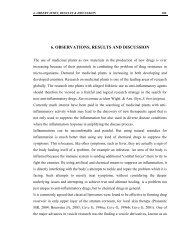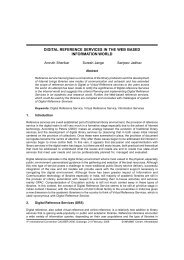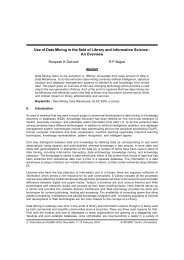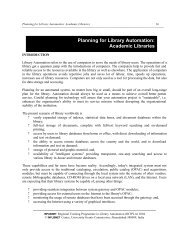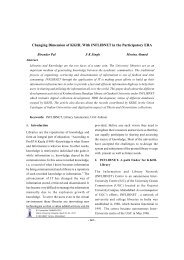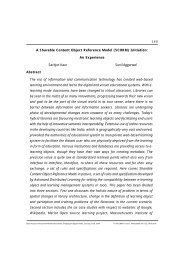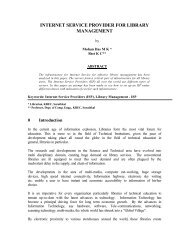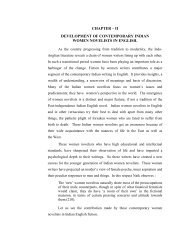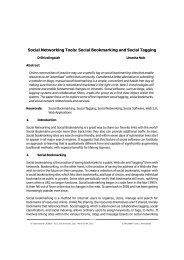Chapter VI Conclusions The basic tenet of drama as a literary form is ...
Chapter VI Conclusions The basic tenet of drama as a literary form is ...
Chapter VI Conclusions The basic tenet of drama as a literary form is ...
You also want an ePaper? Increase the reach of your titles
YUMPU automatically turns print PDFs into web optimized ePapers that Google loves.
<strong>Chapter</strong> <strong>VI</strong><br />
<strong>Conclusions</strong><br />
<strong>The</strong> <strong>b<strong>as</strong>ic</strong> <strong>tenet</strong> <strong>of</strong> <strong>drama</strong> <strong>as</strong> a <strong>literary</strong> <strong>form</strong> <strong>is</strong> its per<strong>form</strong>ance. <strong>The</strong> social real<strong>is</strong>m <strong>is</strong><br />
considered <strong>as</strong> the most important <strong>literary</strong> value in the study <strong>of</strong> selected plays <strong>of</strong> the two<br />
playwrights, P. K. Atre and John Galsworthy. <strong>The</strong> study <strong>is</strong> the compar<strong>is</strong>on <strong>of</strong> the <strong>drama</strong>tic works<br />
<strong>of</strong> these two playwrights. <strong>The</strong> Engl<strong>is</strong>h plays <strong>of</strong> John Galsworthy and the Marathi plays <strong>of</strong> P. K.<br />
Atre are compared here. John Galsworthy belonged to England and h<strong>is</strong> mothertongue <strong>is</strong> Engl<strong>is</strong>h,<br />
he wrote h<strong>is</strong> plays in Engl<strong>is</strong>h where<strong>as</strong> Atre born in Mahar<strong>as</strong>htra and <strong>as</strong> h<strong>is</strong> mothertongue <strong>is</strong><br />
Marathi, he wrote h<strong>is</strong> plays in Marathi. <strong>The</strong>se playwrights are the symbols <strong>of</strong> the new resurgence<br />
in their own are<strong>as</strong> and have made bold innovations, fruitful experiments and have given a new<br />
direction, which goes in the h<strong>is</strong>tory <strong>of</strong> Engl<strong>is</strong>h and Indian <strong>drama</strong> <strong>as</strong> a significant mark <strong>of</strong><br />
achievement. <strong>The</strong> plays <strong>of</strong> these writers are not entertaining but they are thought provoking.<br />
<strong>The</strong>y share contemporary social and national life.<br />
<strong>The</strong>re are some similarities and some differences in them. Atre shows lust, greed and<br />
sufferings <strong>of</strong> women in the lives <strong>of</strong> the contemporary people by using the contemporary setting<br />
and language. John Galsworthy uses the injustice and c<strong>as</strong>te prejudice and welds it with the<br />
contemporary reality. Both the playwrights are prolific writers because they have produced<br />
novels, short stories, adaptions, essays and plays. Both have made a significant contribution to<br />
the Engl<strong>is</strong>h and Marathi <strong>drama</strong>. <strong>The</strong>ir plays are not b<strong>as</strong>ed on the value <strong>of</strong> entertainment but they<br />
provoke the audience to think. <strong>The</strong>y are contemporary writers and both <strong>of</strong> them share the<br />
contemporary social and national concerns <strong>of</strong> their own nations.<br />
After peeping deep into the plays <strong>of</strong> Atre and Galsworthy, it <strong>is</strong> found that Atre’s plays<br />
focus the sufferings <strong>of</strong> women, their suppression and exploitation made by the men and the plays<br />
<strong>of</strong> Galsworthy focus the injustice, c<strong>as</strong>te prejudice, conflicts and sufferings <strong>of</strong> the underdogs.<br />
P. K. Atre and John Galsworthy have tackled the current social problems <strong>of</strong> their<br />
contemporary society in their plays. Both Atre and Galsworthy were real<strong>is</strong>ts and they exposed<br />
social real<strong>is</strong>m through their plays, yet there are slight differences between them in handling the<br />
theme <strong>of</strong> social real<strong>is</strong>m. Atre <strong>of</strong>ten indulged in gross exaggeration where<strong>as</strong> Galsworthy never did<br />
so to achieve the very purpose <strong>of</strong> real<strong>is</strong>m. Atre allowed h<strong>is</strong> own personality to intrude in<br />
presenting the sides <strong>of</strong> a c<strong>as</strong>e, on the contrary Galsworthy presented both the sides <strong>of</strong> a c<strong>as</strong>e with<br />
rigid impartiality and insight, he never intruded himself though he w<strong>as</strong> with the downtrodden in
mind, <strong>as</strong> doing so would destroy the very purpose <strong>of</strong> awakening the conscience in the mind <strong>of</strong><br />
the m<strong>as</strong>ses to abol<strong>is</strong>h social problems. While portraying social real<strong>is</strong>m, Atre almost invariably<br />
attempted at mocking and sc<strong>of</strong>fing at the weaknesses <strong>of</strong> human nature and society but<br />
Galsworthy never attempted to do so. Atre w<strong>as</strong> a blatant propagand<strong>is</strong>t for the intellectual<br />
enlightenment <strong>of</strong> the people, but Galsworthy w<strong>as</strong> never a propagand<strong>is</strong>t <strong>as</strong> he believed in<br />
detachment and objectivity while dealing with a social problem, to Atre <strong>drama</strong> w<strong>as</strong> a means <strong>of</strong><br />
social re<strong>form</strong>ation not preaching where<strong>as</strong> Galsworthy w<strong>as</strong> a preacher not a re<strong>form</strong>er.<br />
P. K. Atre, who w<strong>as</strong> greatly influenced by the plays <strong>of</strong> Ibsen, Shaw, Wells and Noel<br />
Coward, h<strong>as</strong> depicted different social problems in h<strong>is</strong> plays especially he h<strong>as</strong> mainly focused h<strong>is</strong><br />
attention on the burning problems <strong>of</strong> the women during h<strong>is</strong> period. In h<strong>is</strong> plays he depicted the<br />
problems like the problem <strong>of</strong> man-woman relationship, the problem <strong>of</strong> the marriage <strong>of</strong> educated<br />
women, the problems <strong>of</strong> unmarried mothers, and the place <strong>of</strong> a woman in the society and the<br />
sufferings <strong>of</strong> Indian women in general etc. <strong>The</strong> sufferings <strong>of</strong> both educated and the uneducated<br />
women were boundless.<br />
A woman w<strong>as</strong> treated <strong>as</strong> a subordinate thing in a male dominating society.she w<strong>as</strong> treated<br />
<strong>as</strong> a slave, she w<strong>as</strong> expected to work hard and her work w<strong>as</strong> countless and also valuless. Her duty<br />
w<strong>as</strong> to serve and to take care <strong>of</strong> all the members in the family. <strong>The</strong>y had no any right or the<br />
freedom to enjoy their life independently. <strong>The</strong>y were always bound inside the house. On the<br />
contrary the men had every sort <strong>of</strong> freedom. <strong>The</strong>y could enjoy their life <strong>as</strong> they like. <strong>The</strong>re w<strong>as</strong><br />
no any kind <strong>of</strong> restriction on their freedom. <strong>The</strong>y had a license to drink and beat their wives and<br />
treat them recklessly. <strong>The</strong>y could behave with their wives not less than the be<strong>as</strong>ts. <strong>The</strong>y could fly<br />
like a butterfly after any woman they like in order to sat<strong>is</strong>fy their limitless sexual lust. <strong>The</strong>y<br />
could never think <strong>of</strong> their families, wives and the children. Many <strong>of</strong> the times they became the<br />
cause <strong>of</strong> the destruction <strong>of</strong> their families.<br />
A woman <strong>is</strong> always supposed <strong>as</strong> the weaker section in the society so she tolerates the<br />
exploitation and the inhuman treatment given by the men during their whole life but they never<br />
oppose their husbands. A woman <strong>is</strong> the symbol <strong>of</strong> toleration and the Indian women are<br />
recognized for it. <strong>The</strong>y always obey the principles <strong>of</strong> the great Hindu Culture so they tolerate<br />
everything to save their family. But the unfortunate thing <strong>is</strong> that the men never think and pay<br />
their attention at it. That <strong>is</strong> the tragedy <strong>of</strong> Indian women.
P. K. Atre, an eminent <strong>drama</strong>t<strong>is</strong>t <strong>of</strong> the age, paid h<strong>is</strong> heed at these social problems and the<br />
sufferings <strong>of</strong> the women during h<strong>is</strong> period and he depicted it in h<strong>is</strong> some plays. In h<strong>is</strong> play,<br />
‘Gharabaher’ he h<strong>as</strong> presented the real<strong>is</strong>tic picture <strong>of</strong> the sufferings <strong>of</strong> an Indian woman,<br />
Nirmala who faces many calamities in her life only because <strong>of</strong> her husband, Shaunak, who <strong>is</strong><br />
weak, timid and inefficient. If her husband had been a strong and courageous person to protect<br />
her then the tragedy <strong>of</strong> her life would not have taken place. Her father-in-law, Ab<strong>as</strong>aheb who <strong>is</strong><br />
at the age <strong>of</strong> her father but but never treats her like a daughter on the contrary he always tortures<br />
her to sat<strong>is</strong>fy h<strong>is</strong> be<strong>as</strong>tlike sexual lust. Her brother-in-law, Nilkanth <strong>is</strong> the lustiest and wicked<br />
fellow always tries to seduce her and when she opposes to their evil intention they make a blot <strong>of</strong><br />
adultery upon her character for which she helplessly leaves the house. Even Bhay<strong>as</strong>aheb <strong>is</strong> also<br />
the same type <strong>of</strong> man who pretends to be a kind person but in reality he <strong>is</strong> devil in the gu<strong>is</strong>e <strong>of</strong><br />
human being.<br />
Some characters like Padmanabh are good but such good characters suffer because <strong>of</strong> the<br />
evil characters. What actually happens in the society, Atre h<strong>as</strong> employed in h<strong>is</strong> plays. In h<strong>is</strong> play,<br />
‘Udyacha Sansar’ Karuna becomes the victim <strong>of</strong> the man like Br. V<strong>is</strong>hram, her husband. H<strong>is</strong><br />
sexual lust and addiction makes the life <strong>of</strong> Karuna very m<strong>is</strong>erable. He forgets h<strong>is</strong> family<br />
responsibility. As a consequence the whole family <strong>is</strong> d<strong>is</strong>turbed and destroyed. H<strong>is</strong> carelessness<br />
spoils h<strong>is</strong> children when he realizes h<strong>is</strong> m<strong>is</strong>take and tries to repent over it, but it <strong>is</strong> too late, that<br />
h<strong>is</strong> wife Karuna leaves him and the world. Karuna <strong>is</strong> thus the victim <strong>of</strong> the male dominant<br />
society where she <strong>is</strong> crushed under heavy grief and agony.<br />
Atre’s ‘Jag Kay Mhanel’ <strong>is</strong> an excellent comment on the debauchery nature <strong>of</strong> the men.<br />
Deewakar, the husband <strong>of</strong> Ulka, <strong>is</strong> a debauchery person, suspects h<strong>is</strong> faithful and ch<strong>as</strong>te wife and<br />
therefore the family <strong>is</strong> destroyed. Ulka suffers a lot due to the evil treatment given to her by her<br />
husband, she tolerates to a certain extent but finally she breakes the relationship <strong>of</strong> husband and<br />
wife and decides to leave her husband for sake <strong>of</strong> the social work. Atre’s ‘Lagnachi Bedi’,<br />
though it <strong>is</strong> a comedy, it presents the social problems real<strong>is</strong>tically. <strong>The</strong> educated people like Dr.<br />
Kanchan forget their responsibility and run after young lady like R<strong>as</strong>hmi to fulfil h<strong>is</strong> sexual lust.<br />
Most <strong>of</strong> the male characters in the play are full with sexual lust so they forget their family<br />
responsibilities and the families are destroyed and the female characters suffer too much. Thus in<br />
all h<strong>is</strong> plays, selected for the research study, Atre h<strong>as</strong> depicted the social real<strong>is</strong>m very vividly and<br />
real<strong>is</strong>tically.
Like Atre, Galsworthy occupies a conspicuous place <strong>as</strong> a writer <strong>of</strong> real<strong>is</strong>tic plays in<br />
modern Engl<strong>is</strong>h <strong>drama</strong>. H<strong>is</strong> plays deal with the problems <strong>of</strong> contemporary life in a real<strong>is</strong>tic<br />
manner. To a large extent h<strong>is</strong> plays deal with the problems <strong>of</strong> contemporary social life. He deftly<br />
combines the real<strong>is</strong>m <strong>of</strong> a social re<strong>form</strong>er with the m<strong>is</strong>sionary outlook <strong>of</strong> an ideal<strong>is</strong>t. Galsworthy<br />
maintains complete impartiality and objectivity in the presentation <strong>of</strong> social reality. He aims at<br />
the representation <strong>of</strong> contemporary life in its familiar everyday <strong>as</strong>pects. H<strong>is</strong> presentation and<br />
critic<strong>is</strong>m <strong>of</strong> social questions earned for him the reputation <strong>of</strong> a powerful social real<strong>is</strong>t in Engl<strong>is</strong>h<br />
<strong>drama</strong>.<br />
John Galsworthy w<strong>as</strong> a social re<strong>form</strong>er and a philanthrop<strong>is</strong>t by temperament. Like P. K.<br />
Atre, John Galsworthy also depicted various social problems real<strong>is</strong>tically from h<strong>is</strong> contemporary<br />
society in h<strong>is</strong> plays. But h<strong>is</strong> problems are slightly different from the problems depicted by Atre in<br />
h<strong>is</strong> plays. Galsworthy w<strong>as</strong> a <strong>drama</strong>t<strong>is</strong>t <strong>of</strong> social life and concentrated h<strong>is</strong> attention on the<br />
problems in h<strong>is</strong> society. He found h<strong>is</strong> material and inspiration in the world <strong>of</strong> every day life and<br />
affairs. He maintained a real<strong>is</strong>tic attitude in h<strong>is</strong> <strong>drama</strong>s cons<strong>is</strong>tently. He treated the social<br />
problems in relation to the individual or the family. He depicted the problems <strong>of</strong> marriage, sex<br />
relationship, labour d<strong>is</strong>putes, admin<strong>is</strong>tration <strong>of</strong> law, cl<strong>as</strong>s or the c<strong>as</strong>te prejudice etc.<br />
Galsworthy’s first play, ‘<strong>The</strong> Silver Box’ deals with the contemporary crucial problem<br />
regarding the admin<strong>is</strong>tration <strong>of</strong> law, one law for the rich and another for the poor. <strong>The</strong> play<br />
throws light on how the law can be purch<strong>as</strong>ed by the power <strong>of</strong> wealth and the rich, though<br />
commits a crime, sets free where<strong>as</strong>, the poor having no any guilt, <strong>is</strong> pun<strong>is</strong>hed. Th<strong>is</strong> partiality <strong>of</strong><br />
the contemporary law h<strong>as</strong> been reflected in <strong>The</strong> Silver Box. <strong>The</strong> success <strong>of</strong> th<strong>is</strong> play <strong>is</strong> that the<br />
Brit<strong>is</strong>h Govt. made necessary changes in the admin<strong>is</strong>tration <strong>of</strong> law. H<strong>is</strong>, ‘Strife’ <strong>is</strong> a beautiful<br />
indictment <strong>of</strong> the present industrial society. It presents the strife between capital and the labour<br />
and advocates better understanding between these two great forces <strong>of</strong> industrial life. <strong>The</strong> play<br />
conveys a universal message that any kind <strong>of</strong> struggle <strong>is</strong> not good. It leads to the heavy loss and<br />
causes great destruction and tremendous sufferings <strong>of</strong> poor, innocent people and sometimes<br />
nothing good comes out <strong>of</strong> it.<br />
<strong>The</strong> unnecessary strikes and lock-outs hamper the progress <strong>of</strong> industrial life and retard<br />
the production. Galsworthy h<strong>as</strong> brought to the notice <strong>of</strong> the world th<strong>is</strong> real<strong>is</strong>tic social problem<br />
through h<strong>is</strong> social play- ‘Strife’. H<strong>is</strong> other play ‘Justice’ <strong>is</strong> a social tragedy. It <strong>is</strong> a play that deals<br />
with the problems <strong>of</strong> the criminal and the treatment <strong>of</strong> the society towards such criminals.
Galsworthy shows that a man who commits some theft under very straitend circumstances like<br />
Falder should be subjected to the course <strong>of</strong> law, because it <strong>is</strong> the society that <strong>is</strong> mainly<br />
responsible for the turning <strong>of</strong> innocent people into sinners. <strong>The</strong> judge should have also taken into<br />
consideration Falder’s help to a helpless woman in humanitarian point <strong>of</strong> view. Galsworthy<br />
criticizes the contemporary justice in th<strong>is</strong> play. Galsworthy’s ‘Loyalties’ <strong>is</strong> a play in which the<br />
<strong>drama</strong>t<strong>is</strong>t deals with the subject <strong>of</strong> c<strong>as</strong>te prejudice or the c<strong>as</strong>te feelings. It <strong>is</strong> the cry against racial<br />
prejudice shown by the Chr<strong>is</strong>tains to a Jew. <strong>The</strong> <strong>drama</strong>t<strong>is</strong>t h<strong>as</strong> employed different kinds <strong>of</strong> the<br />
loyalties in th<strong>is</strong> play such <strong>as</strong> the loyalty <strong>of</strong> race, loyalty to friendship, pr<strong>of</strong>essional loyalty and the<br />
loyalty to the married life etc. John Galsworthy’s these four plays that are selected for the study<br />
are dealt with the theme <strong>of</strong> social real<strong>is</strong>m.<br />
<strong>The</strong> aim <strong>of</strong> the present research work <strong>is</strong> to compare and contr<strong>as</strong>t the social ide<strong>as</strong> and<br />
problems depicted in their plays by the Marathi <strong>drama</strong>t<strong>is</strong>t, P. K. Atre, a Mahar<strong>as</strong>htrian <strong>drama</strong>t<strong>is</strong>t<br />
and John Galsworthy, Engl<strong>is</strong>h <strong>drama</strong>t<strong>is</strong>t from England. Though, both the <strong>drama</strong>t<strong>is</strong>ts belonged to<br />
different countries and the different periods, their aim w<strong>as</strong> same that to present different crucial<br />
social problems during their contemporary society.<br />
Atre and Galsworthy, these two <strong>drama</strong>t<strong>is</strong>ts from the real<strong>is</strong>t tradition, focused in their<br />
plays on the types <strong>of</strong> contemporary social problems and their incredible repercussions on the<br />
society.<br />
<strong>The</strong> study aims at clarifying the position <strong>of</strong> Atre and Galsworthy in the battle <strong>of</strong><br />
reestabl<strong>is</strong>hing better human society on the earth in the midst <strong>of</strong> snarled social conventions. <strong>The</strong><br />
purpose <strong>is</strong> to analyse the <strong>drama</strong>tic products <strong>of</strong> Atre and Galsworthy and to find out the causes<br />
and natures <strong>of</strong> human suffering, especially the suffering <strong>of</strong> the underdog, the downtrodden, the<br />
poor, the workers, the women, the suppressed and the oppressed etc. Both Atre and Galsworthy<br />
were uncomprom<strong>is</strong>ing real<strong>is</strong>ts who exposed various manifestations <strong>of</strong> social malevolence in their<br />
plays. <strong>The</strong>y kept in mind detachment and objectivity in dealing with social problems. <strong>The</strong>y were<br />
not conscious <strong>of</strong> any desire to solve those those problems in their plays or to effect great re<strong>form</strong>s.<br />
<strong>The</strong>ir only ambition in <strong>drama</strong>, <strong>as</strong> in other works, w<strong>as</strong> to present truthfully real<strong>is</strong>tic problems in<br />
their contemporary society.<br />
Undoubtedly Atre w<strong>as</strong> the greatest <strong>drama</strong>t<strong>is</strong>t <strong>of</strong> h<strong>is</strong> own age. P. K. Atre’s <strong>drama</strong>tic career<br />
w<strong>as</strong> sensational. When he arrived on the Marathi stage, at that time, Marathi stage w<strong>as</strong> on the<br />
verge <strong>of</strong> declining. But it w<strong>as</strong> Atre who created liveliness and gave new direction to the Marathi
<strong>drama</strong>. It w<strong>as</strong> really the rebirth <strong>of</strong> Marathi <strong>drama</strong> after Kirloskar, Kolhatkar and R. G. Gadkari.<br />
Marathi <strong>drama</strong> flour<strong>is</strong>hed and became popular all over the world only because <strong>of</strong> the<br />
innumerable efforts made by Atre.<br />
When Atre started writing <strong>drama</strong>, he faced several problems that the great actors <strong>of</strong> the<br />
time like Balgandharv and others had stopped to play their roles in Marathi <strong>drama</strong> <strong>as</strong> they were<br />
acting in Marathi Movies, even the t<strong>as</strong>te <strong>of</strong> the audience w<strong>as</strong> changed so much so that they were<br />
also attracted to the Marathi Movies and the popular actors were not ready to play the female<br />
role on the stage, these and many other problems were created but inspite <strong>of</strong> these problems, Atre<br />
continued writing <strong>drama</strong> and he succeeded in h<strong>is</strong> efforts. When the theatre-goers and the<br />
Managers realized the greatness <strong>of</strong> h<strong>is</strong> plays that Atre h<strong>as</strong> employed and criticized various social<br />
problems in the contemporary society, the theatres became housefull with audience. Balmohan<br />
Natak Mandal <strong>of</strong> Puna took painstaking efforts to popularize the plays <strong>of</strong> Atre. Very honestly<br />
Atre gave the whole credit <strong>of</strong> the success <strong>of</strong> h<strong>is</strong> plays to Balmohan Natak Mandali and it <strong>is</strong> the<br />
greatness <strong>of</strong> Atre <strong>as</strong> a <strong>drama</strong>t<strong>is</strong>t and h<strong>is</strong> plays.<br />
At the time when Atre w<strong>as</strong> writing plays, the people in the society were not well educated<br />
and well civilized and they believed in superstitions and blind faiths, even the educated people<br />
were also behaving like uneducated or the savage people and it led to create several problems.<br />
Women <strong>of</strong> the time were facing several problems they had no any kind <strong>of</strong> freedom, they<br />
were treated <strong>as</strong> the toys or the slaves. <strong>The</strong>y had to do a lot <strong>of</strong> work in and outside the home but<br />
their work were not counted because woman w<strong>as</strong> a subordinate thing. <strong>The</strong> society w<strong>as</strong><br />
dominated by the men. In h<strong>is</strong> plays Atre h<strong>as</strong> mainly focused h<strong>is</strong> attention on the problems and<br />
the sufferings <strong>of</strong> the women. Women were exploited and treated harshly by the men. <strong>The</strong><br />
sufferings <strong>of</strong> the women were endless. <strong>The</strong>ir place in the home w<strong>as</strong> not better than the dog. In<br />
fact, because <strong>of</strong> the heavy stress and inhuman treatment, they were either leaving home or<br />
commited suicide to end the sufferings. <strong>The</strong> women at the time were under heavy stress and<br />
terror. <strong>The</strong>ir mentle condition w<strong>as</strong> so horrible.<br />
In h<strong>is</strong> four plays that selected for th<strong>is</strong> research study- Udyacha Sansar, Gharbaher, and<br />
Jag Kay Mhanel & Lagnachi Bedi, Atre h<strong>as</strong> tackled the real<strong>is</strong>tic social problem especially the<br />
problem <strong>of</strong> the women in h<strong>is</strong> contemporary society. <strong>The</strong>se four plays <strong>of</strong> Atre are regarded <strong>as</strong> the<br />
serious plays. <strong>The</strong>se plays are related to the domestic problems and social traditions. When Ate<br />
wrote these plays, he w<strong>as</strong> deeply influenced by the plays <strong>of</strong> Norwegian <strong>drama</strong>t<strong>is</strong>t Henrik Ibsen
and the Brit<strong>is</strong>h <strong>drama</strong>t<strong>is</strong>ts G. B. Shaw and Noel Coward. <strong>The</strong>se plays make a critical examination<br />
<strong>of</strong> the different problems <strong>of</strong> women. Traditional domination <strong>of</strong> husbands over their wives, the<br />
painful situations and sufferings <strong>of</strong> women under the man-made rules <strong>is</strong> the subject <strong>of</strong> these<br />
plays. Atre presented serious themes in a comic manner. Exaggerated facts and witty dialogues<br />
were the strongest weapons <strong>of</strong> Atre. H<strong>is</strong> plays are life like. Ep<strong>is</strong>odes, incidents and stories are<br />
common and they are selected from middle cl<strong>as</strong>s families. In few plays he h<strong>as</strong> used fl<strong>as</strong>h back<br />
technique which had been developed by Ibsen. Effective dialogues and modern technique w<strong>as</strong><br />
strength <strong>of</strong> h<strong>is</strong> plays.<br />
Another <strong>drama</strong>t<strong>is</strong>t selected for th<strong>is</strong> research study <strong>is</strong> John Galsworthy from England. He<br />
w<strong>as</strong> <strong>b<strong>as</strong>ic</strong>ally a social re<strong>form</strong>er. Like Atre, Galsworthy too employed burning social problems in<br />
h<strong>is</strong> society but h<strong>is</strong> problems were different from that <strong>of</strong> Atre. Galsworthy presented the problems<br />
like injustice, cl<strong>as</strong>s and c<strong>as</strong>te d<strong>is</strong>crimination, the problems <strong>of</strong> the workers, the d<strong>is</strong>putes between<br />
employer and employee the struggle between Jews and Chr<strong>is</strong>tians etc. he depicted the familiar<br />
<strong>as</strong>pects <strong>of</strong> every day life in a natural manner. He exposed the <strong>drama</strong>tic possibilities <strong>of</strong> the<br />
common place. He minutely observed life around him and tried to create in h<strong>is</strong> plays an<br />
atmosphere <strong>of</strong> absolute truth. He endeavoured to depict the real<strong>is</strong>tic picture <strong>of</strong> society and its<br />
problems. But he did not hold any view on social or moral progress <strong>of</strong> mankind. He analysed<br />
problems and institutions, particularly Engl<strong>is</strong>h ones, from the point <strong>of</strong> view <strong>of</strong> a liberal<br />
comp<strong>as</strong>sionate, upper middle-cl<strong>as</strong>s man. H<strong>is</strong> civilized social critic<strong>is</strong>m reflects the virtues <strong>of</strong> such<br />
a mind. He observed complete impartiality in the treatment <strong>of</strong> social real<strong>is</strong>m, an incorruptible<br />
lover <strong>of</strong> truth, he attemped to shape all h<strong>is</strong> plots and problems with the gretest impartiality,<br />
allowing both sides <strong>of</strong> their opinions and throwing light on their ide<strong>as</strong> in all possible way. All h<strong>is</strong><br />
plays exhibit the same features- the omnipresence <strong>of</strong> a fundamental social problems expressed in<br />
a severely natural manner, without straining <strong>of</strong> situations or exaggeration <strong>of</strong> final <strong>is</strong>sues, a<br />
corresponding real<strong>is</strong>m <strong>of</strong> dialogue, leading at times to an apperent ordinariness, a native<br />
kindliness <strong>of</strong> heart added to the sternness <strong>of</strong> the true tragic art<strong>is</strong>t and a complete absence <strong>of</strong><br />
sentimental<strong>is</strong>m even when pitiful scenes are introduced. He tried to draw the attention <strong>of</strong> the<br />
people in the society to the problems through h<strong>is</strong> plays like- Strife, <strong>The</strong> Silver Box, Justice and<br />
Loyalties.<br />
As a writer <strong>of</strong> real<strong>is</strong>tic plays, Galsworthy very skillfully reproduced <strong>of</strong> absolute reality.<br />
H<strong>is</strong> plays are solid and honest with no ornamentation, no claptrap. H<strong>is</strong> plays are treated <strong>as</strong> the
problem plays <strong>as</strong> he ra<strong>is</strong>es the problems in h<strong>is</strong> plays and leaves them audience to answer. In<br />
‘Strife’ Galsworthy draws attention to the wrongs done to the labor community by depicting its<br />
sorrows and sufferings and taking the strife in the limits <strong>of</strong> the workers capacity to endure. <strong>The</strong><br />
play shows the conflict between the forces <strong>of</strong> capital and the labor, in the cl<strong>as</strong>h between these<br />
two forces, each led by extrem<strong>is</strong>ts, thousands <strong>of</strong> families or poor labourers suffer untold<br />
hardships.<strong>The</strong> Silver Box presents the helplessness <strong>of</strong> the poor which leads to their victimization<br />
that cause great trouble and d<strong>is</strong>tress to them and the law and its min<strong>is</strong>ters are <strong>of</strong> little use to them.<br />
In th<strong>is</strong> play one can imagine what suffering awaits Mrs. Jones and her poor children after the<br />
play <strong>is</strong> over. <strong>The</strong> play reveals the truth <strong>of</strong> the old adage that there <strong>is</strong> one law for the rich and<br />
another for the poor. <strong>The</strong> society with its ominous inv<strong>is</strong>ible presence decides that the rich shall<br />
be preferred to the poor. Justice presents the evils <strong>of</strong> pr<strong>is</strong>on life especially the evils <strong>of</strong> solitary<br />
confinement.in th<strong>is</strong> play there <strong>is</strong> not a single evil character, but once the spirit <strong>of</strong> the law h<strong>as</strong><br />
been invoked, the wheels <strong>of</strong> the machine <strong>of</strong> justice griend Falder to bits. In th<strong>is</strong> play Galsworthy<br />
shows the cruelty <strong>of</strong> the Engl<strong>is</strong>h judicial system and the heartless destruction <strong>of</strong> innocent lives<br />
that causes without presenting a single villain. It deals with the situation <strong>of</strong> a weak willed young<br />
man who forges a cheque in order to get money to help h<strong>is</strong> unhappy married lover to finda new<br />
life. In th<strong>is</strong> play, Galsworthy vividly exposes the inefficiency <strong>of</strong> the admin<strong>is</strong>tration <strong>of</strong> justice and<br />
the evils in jail admin<strong>is</strong>tration. It <strong>is</strong> conceived <strong>as</strong> an ecst<strong>as</strong>y <strong>of</strong> rage against human oppression.<br />
<strong>The</strong> play Loyalties shows the cl<strong>as</strong>hing loyalties <strong>of</strong> various characters- loyalty to one’s race, to<br />
one’s friends, to one’s family and to one’s pr<strong>of</strong>ession. In th<strong>is</strong> play Galsworthy succeeded in<br />
expounding the very idea <strong>of</strong> social real<strong>is</strong>m. <strong>The</strong> play deals with anti-jew<strong>is</strong>h feeling and<br />
d<strong>is</strong>crimination against racial minority.<br />
Atre and Galsworthy were witty real<strong>is</strong>ts who loved to present people with the absurdity<br />
<strong>of</strong> their conventional way <strong>of</strong> thinking. <strong>The</strong>ir satires range widely over such real subjects <strong>as</strong><br />
hero<strong>is</strong>m in war, physicians and their power over life and death, religion, the battle <strong>of</strong> the sexes,<br />
education, justice, cl<strong>as</strong>s prejudices and labour problems. In their plays they have combined<br />
real<strong>is</strong>tic moral problems with ironic tone and paradoxes. D<strong>is</strong>cussions and intellectual acrobatics<br />
are the b<strong>as</strong><strong>is</strong> <strong>of</strong> their <strong>drama</strong>. Although Atre and Galsworthy’s plays focus on real life ide<strong>as</strong> and<br />
<strong>is</strong>sues, they are vital and absorbing, enlivened by memorable characterizations, a brilliant<br />
command over language and dazzling wit. <strong>The</strong>y were successful in rec<strong>as</strong>ting the real<strong>is</strong>t tradition<br />
in <strong>drama</strong>.
Both Atre and Galsworthy have drawn their characters from their observations <strong>of</strong> persons<br />
around them. <strong>The</strong>ir characters are, therefore, living human beings <strong>of</strong> flesh and blood. <strong>The</strong>y are<br />
all Indian and Engl<strong>is</strong>h men and women having the common human virtues and frailties. <strong>The</strong>y<br />
have only transferred living men and women from the home, the <strong>of</strong>fice, the factory, the law court<br />
and the street to their stage. <strong>The</strong>y both have created a large number <strong>of</strong> living characters in their<br />
plays. <strong>The</strong>y know how to tell the good story and create <strong>drama</strong>tic situations. <strong>The</strong>ir dialogues are<br />
cr<strong>is</strong>p and witty and contribute to the development <strong>of</strong> plot and character. <strong>The</strong>y know how to<br />
create suspense and a proper atmosphere in a play. <strong>The</strong>y have clear-cut theory <strong>of</strong> <strong>drama</strong> and they<br />
have faithfully followed it in their plays. All th<strong>is</strong> makes them the most pol<strong>is</strong>hed <strong>drama</strong>tic<br />
craftsmen <strong>of</strong> their age.<br />
Both Atre and Galsworthy were the real<strong>is</strong>ts. <strong>The</strong>ir plays are b<strong>as</strong>ed on the real life<br />
situations that they saw around them in India and in England. <strong>The</strong>ir characters, their themes and<br />
their dialogues are b<strong>as</strong>ed on the life that they have seen around them. <strong>The</strong>y were so truthful to<br />
the contemporary life in India and England that it can be rightly said that their plays can be taken<br />
to be the social chronicles <strong>of</strong> India and England <strong>of</strong> their time.<br />
Both Atre and Galsworthy were obsessed with the thought <strong>of</strong> social re<strong>form</strong>ation, both<br />
were social re<strong>form</strong>ers so their inner mind did allow them to keep quite and watch the sufferings,<br />
m<strong>is</strong>ery, helplessness, sqeeizing and the exploitation <strong>of</strong> the downtrodden, poor workers and<br />
women. Both have presented the real<strong>is</strong>tic social problems in their society. Though the problems<br />
were different their aim w<strong>as</strong> same that to throw light on these social problems and bring them to<br />
the notice <strong>of</strong> the people. <strong>The</strong>y succeeded in their efforts and certainly the people in their society<br />
might have learnt something good from these plays.<br />
Both Atre and Galsworthy were greatly impressed and influenced by the plays <strong>of</strong> Henrik<br />
Ibsen, a Norweign <strong>drama</strong>t<strong>is</strong>t. Both have tackled the burning social problems in their own society,<br />
they have given new direction to the real<strong>is</strong>tic <strong>drama</strong> in their own countries and tried to show a<br />
good path to people in their society. Th<strong>is</strong> research study examines the concept <strong>of</strong> love, sex,<br />
women’s status, workers problems <strong>as</strong> an independent human being in a given social and family<br />
order and their right for self development, the institution <strong>of</strong> marriage, the d<strong>is</strong>tinction between<br />
Indian and Western cultures, the problems <strong>of</strong> educated unmarried adult women, the problems <strong>of</strong><br />
workers, legel system, poverty, sufferings <strong>of</strong> poor, social injustice, conflict and the concept <strong>of</strong><br />
family in India and Europe with reference to the domination <strong>of</strong> male over the female.
Both P. K. Atre and John Galsworthy have very faithfully portrayed Indian and Brit<strong>is</strong>h life<br />
in their plays. <strong>The</strong>y do invent but they have only recorded what they saw around them in their<br />
own societies. <strong>The</strong>y do not make their world beautiful or strange, their world <strong>is</strong> familier and real<br />
world. So, from the plays <strong>of</strong> both the <strong>drama</strong>t<strong>is</strong>ts- P. K. Atre and John Galsworthy, one can<br />
truthfully reconstruct the Indian and Brit<strong>is</strong>h life <strong>as</strong> it w<strong>as</strong> in the first quarter <strong>of</strong> the twentieth<br />
century.<br />
<strong>The</strong> purpose and the function <strong>of</strong> <strong>Chapter</strong> No. 1 <strong>is</strong> to d<strong>is</strong>cuss briefly the hypothes<strong>is</strong>,<br />
significance and the scope and limitations <strong>of</strong> the present study, to define clearly the objectives <strong>of</strong><br />
the study, review <strong>of</strong> literature, to have a brief survey <strong>of</strong> the development <strong>of</strong> the <strong>form</strong> <strong>of</strong> <strong>drama</strong> in<br />
India <strong>as</strong> well <strong>as</strong> in England and to have a brief introduction to the lives and works <strong>of</strong> P. K. Atre<br />
and John Galsworthy.<br />
<strong>The</strong> purpose and the function <strong>of</strong> the second chapter, <strong>is</strong> to d<strong>is</strong>cuss briefly the method to be<br />
used in the present study. Th<strong>is</strong> chapter <strong>as</strong> far <strong>as</strong> possible defines clearly the specific method to be<br />
used to carryout the proposed study. Thus the first two chapters provide the necessary critical<br />
background and the theoretical framework to the present study.<br />
<strong>The</strong> main objective and the purpose <strong>of</strong> the present study are to analyse and interprete the<br />
social real<strong>is</strong>m <strong>of</strong> the selected plays <strong>of</strong> the two selected playwrights: P. K. Atre and John<br />
Galsworthy. A sincere attempt <strong>is</strong> made to achieve these objectives in the <strong>Chapter</strong> No. 3 and 4, in<br />
which the four selected plays <strong>of</strong> P. K. Atre in Marathi and four selected plays <strong>of</strong> John<br />
Galsworthy in Engl<strong>is</strong>h are d<strong>is</strong>cussed respectively.<br />
Another significant objective <strong>of</strong> the present study <strong>is</strong> to have a comparative perspective <strong>of</strong><br />
the eight selected plays by the two selected playwrights with reference to the social real<strong>is</strong>m <strong>of</strong><br />
the plays. A sincere attempt <strong>is</strong> made to achieve these objectives in <strong>Chapter</strong> No. 5.<br />
<strong>Chapter</strong> No. 6, the present one, <strong>is</strong> an attempt to have a sort <strong>of</strong> conclusion <strong>of</strong> the present<br />
study, though broadly speaking it <strong>is</strong> an epilogue rather than conclusion because in literature there<br />
<strong>is</strong> always scope for further studies. Great <strong>literary</strong> works are like Gold mines, the more you dig,<br />
the more you get and hence <strong>Chapter</strong> No. 6 may be regarded <strong>as</strong> the epilogue <strong>of</strong> the present study.<br />
In th<strong>is</strong> context following observations are made:<br />
First there are certain common techniques used by P. K .Atre and John Galsworthy in their<br />
plays selected for the study, especially the use <strong>of</strong> plot, action, conflict, character, dialogue and
language. However, they are used <strong>b<strong>as</strong>ic</strong>ally to interprete the modern realities <strong>of</strong> human life. A<br />
detailed comparative view <strong>of</strong> their techniques <strong>is</strong> already d<strong>is</strong>cussed in <strong>Chapter</strong> No. 5.<br />
In the context <strong>of</strong> the social real<strong>is</strong>m <strong>of</strong> the selected plays <strong>of</strong> Atre and Galsworthy, <strong>as</strong><br />
d<strong>is</strong>cussed above in the present chapter, we find suppression and oppression <strong>of</strong> women in the<br />
plays <strong>of</strong> Atre and social injustice, c<strong>as</strong>te prejudice and conflict in the plays <strong>of</strong> Galsworthy are the<br />
dominant themes tackled by the playwrights.<br />
In the first chapter Introduction, three possibilities were mentioned while d<strong>is</strong>cussing the<br />
hypothes<strong>is</strong> <strong>of</strong> the study:<br />
1. <strong>The</strong> two playwrights have entirely different views <strong>of</strong> human life or human predicament.<br />
2. <strong>The</strong> two playwrights have something common and they share to a limited extent a partial<br />
view <strong>of</strong> human predicament.<br />
3. <strong>The</strong> v<strong>is</strong>ion <strong>of</strong> life or the concept <strong>of</strong> human predicament <strong>of</strong> both the playwrights <strong>is</strong> mostly<br />
identical and they have almost the same view <strong>of</strong> the human life. Obviously enough, the present<br />
study reveals that the first hypothes<strong>is</strong> <strong>is</strong> entirely wrong and the second hypothes<strong>is</strong> <strong>is</strong> also partial.<br />
<strong>The</strong> study reveals that the third hypothes<strong>is</strong> <strong>is</strong> very significant and relevant. In th<strong>is</strong> context P. K.<br />
Atre and John Galsworthy have penetrated deeply into the human life p<strong>as</strong>t and present. <strong>The</strong>ir<br />
perception <strong>of</strong> human life reveals in their selected plays.




